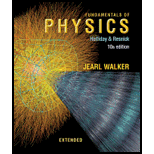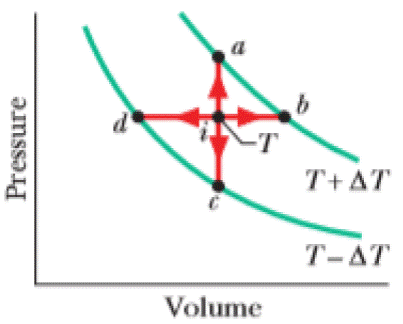
Point i in Fig. 20-19 represents the initial state of an ideal gas at temperature T. Taking algebraic signs into account, rank the entropy changes that the gas undergoes as it moves, successively and reversibly, from point i to points a, b, c, and d, greatest first.

Figure 20-19 Question 1.
To rank:
The entropy changes that the gas undergoes as it moves successively and reversibly from point
Answer to Problem 1Q
Solution:
The ranking of the change of entropy of the gas is
Explanation of Solution
1) Concept:
We can compare the entropy changes of the gas at different points from specific heat and temperature at that points using the relation between change in entropy, specific heat, and temperature at the given point.
2) Formulae:
i)
ii)
3) Given:
The figure showing point
4) Calculations:
In
There are four processes in which two of them are at a higher temperature and two of them are at a lower temperature. The points
The process in which heat is absorbed leads to an increase in the temperature and entropy of the gas. S, o the change of entropy of the gas is positive.
The process that releases energy in the form of heat leads to decrease in entropy. i.e.
The molar specific heat at constant pressure is greater than constant volume, i.e.
The points
For an isobaric process,
For an isochoric process,
So the change of entropy is larger for the isobaric process.
Hence, entropy change is greater at point b and d than at point a and c.
Since b is at a higher temperature than that of d and a is at a higher temperature than that of c.
Therefore, the ranking of the entropy changes of the gas is
Conclusion:
Entropy change depends on temperature and specific heat of an ideal gas.
Want to see more full solutions like this?
Chapter 20 Solutions
Fundamentals of Physics Extended
Additional Science Textbook Solutions
Conceptual Physics: The High School Physics Program
College Physics (10th Edition)
Tutorials in Introductory Physics
University Physics Volume 3
Fundamentals Of Thermodynamics
Applied Physics (11th Edition)
- Is it possible for a system to have an entropy change if it neither absorbs nor emits heat during a reversible? transition? What happens it the process is irreversible?arrow_forwardWhich of the following is true for the entropy change of a system that undergoes a reversible, adiabatic process? (a) S 0 (b) S = 0 (c) S 0arrow_forwardTwo moles of a monatomic ideal gas such as oxygen is compressed adiabatically and reversibly from a state (3 atm, 5 L) to a state with a pressure of 4 atm. (a) Find the volume and temperature of the final state. (b) Find the temperature of the initial state. (c) Find work done by the gas in the process. (d) Find the change in internal energy in the process. Assume Cv=5R and Cp=Cv+R for the diatomic ideal gas in the conditions given.arrow_forward
- In a diesel engine, the fuel is ignited without a spark plug. Instead, air in a cylinder is compressed adiabatically to a temperature above the ignition temperature of the fuel; at the point of maximum compression, the fuel is injected into the cylinder. Suppose that air at 20 C is taken into the cylinder at a volume V1 and then compressed adiabatically and quasi-statically to a temperature of 600 C and a volume V2 . If =1.4 , what is the ratio V1/V2 ? (Note: static. In an operating diesel engine, the compression is not quasi-arrow_forwardAn ideal gas is taken from an initial temperature Ti to a higher final temperature Tf along two different reversible paths. Path A is at constant pressure, and path B is at constant volume. What is the relation between the entropy changes of the gas for these paths? (a) SA SB (b) SA = SB (c) SA SBarrow_forwardTrue or False: The entropy change in an adiabatic process must be zero because Q = 0.arrow_forward
- Consider cyclic processes completely characterized by each of the following net energy inputs and outputs. In each case, the energy transfers listed are the only ones occurring. Classify each process as (a) possible, (b) impossible according to the first law of thermodynamics, (c) impossible according to the second law of thermodynamics, or (d) impossible according to both the first and second laws. (i) Input is 5 J of work, and output is 4 J of work. (ii) Input is 5 J of work, and output is 5 J of energy transferred by heat. (iii) Input is 5 J of energy transferred by electrical transmission, and output is 6 J of work. (iv) Input is 5 J of energy transferred by heat, and output is 5 J of energy transferred by heat. (v) Input is 5 J of energy transferred by heat, and output is 5 J of work. (vi) Input is 5 J of energy transferred by heat, and output is 3 J of work plus 2 J of energy transferred by heat.arrow_forwardAssume a sample of an ideal gas is at room temperature. What action will necessarily make the entropy of the sample increase? (a) Transfer energy into it by heat. (b) Transfer energy into it irreversibly by heat. (c) Do work on it. (d) Increase either its temperature or its volume, without letting the other variable decrease. (e) None of those choices is correct.arrow_forwardA cylinder contains 500 g of helium at 120 atm and 20 . The valve is leaky, and all the gas slowly escapes isothermally into the atmosphere. Use the results of the preceding problem to determine the resulting change in entropy of the universe.arrow_forward
- A sealed container holding 0.500 kg of liquid nitrogen at its boiling point of 77.3 K is placed in a large room at 21.0C. Energy is transferred from the room to the nitrogen as the liquid nitrogen boils into a gas and then warms to the rooms temperature. (a) Assuming the rooms temperature remains essentially unchanged at 21.0C, calculate the energy transferred from the room to the nitrogen. (b) Estimate the change in entropy of the room. Liquid nitrogen has a latent heat of vaporization of 2.01 105 J/kg. The specific heat of N2 gas at constant pressure is CN2 = 1.04 103J/kg K.arrow_forwardDoes the entropy increase for a Carnot engine for each cycle?arrow_forward(a) infinitesimal amount of heat is added reversibly to a system. By combining the first and second laws, show that dU=TdSdW. (b) When heat is added to an ideal gas, its temperature and volume change from T1 and V1 to T2 and V2 . Show that the entropy change of n moles of the gas is given by S=CnvlnT2T1nRlnV2V1 .arrow_forward
 Principles of Physics: A Calculus-Based TextPhysicsISBN:9781133104261Author:Raymond A. Serway, John W. JewettPublisher:Cengage Learning
Principles of Physics: A Calculus-Based TextPhysicsISBN:9781133104261Author:Raymond A. Serway, John W. JewettPublisher:Cengage Learning
 Physics for Scientists and Engineers: Foundations...PhysicsISBN:9781133939146Author:Katz, Debora M.Publisher:Cengage Learning
Physics for Scientists and Engineers: Foundations...PhysicsISBN:9781133939146Author:Katz, Debora M.Publisher:Cengage Learning College PhysicsPhysicsISBN:9781305952300Author:Raymond A. Serway, Chris VuillePublisher:Cengage Learning
College PhysicsPhysicsISBN:9781305952300Author:Raymond A. Serway, Chris VuillePublisher:Cengage Learning College PhysicsPhysicsISBN:9781285737027Author:Raymond A. Serway, Chris VuillePublisher:Cengage Learning
College PhysicsPhysicsISBN:9781285737027Author:Raymond A. Serway, Chris VuillePublisher:Cengage Learning




